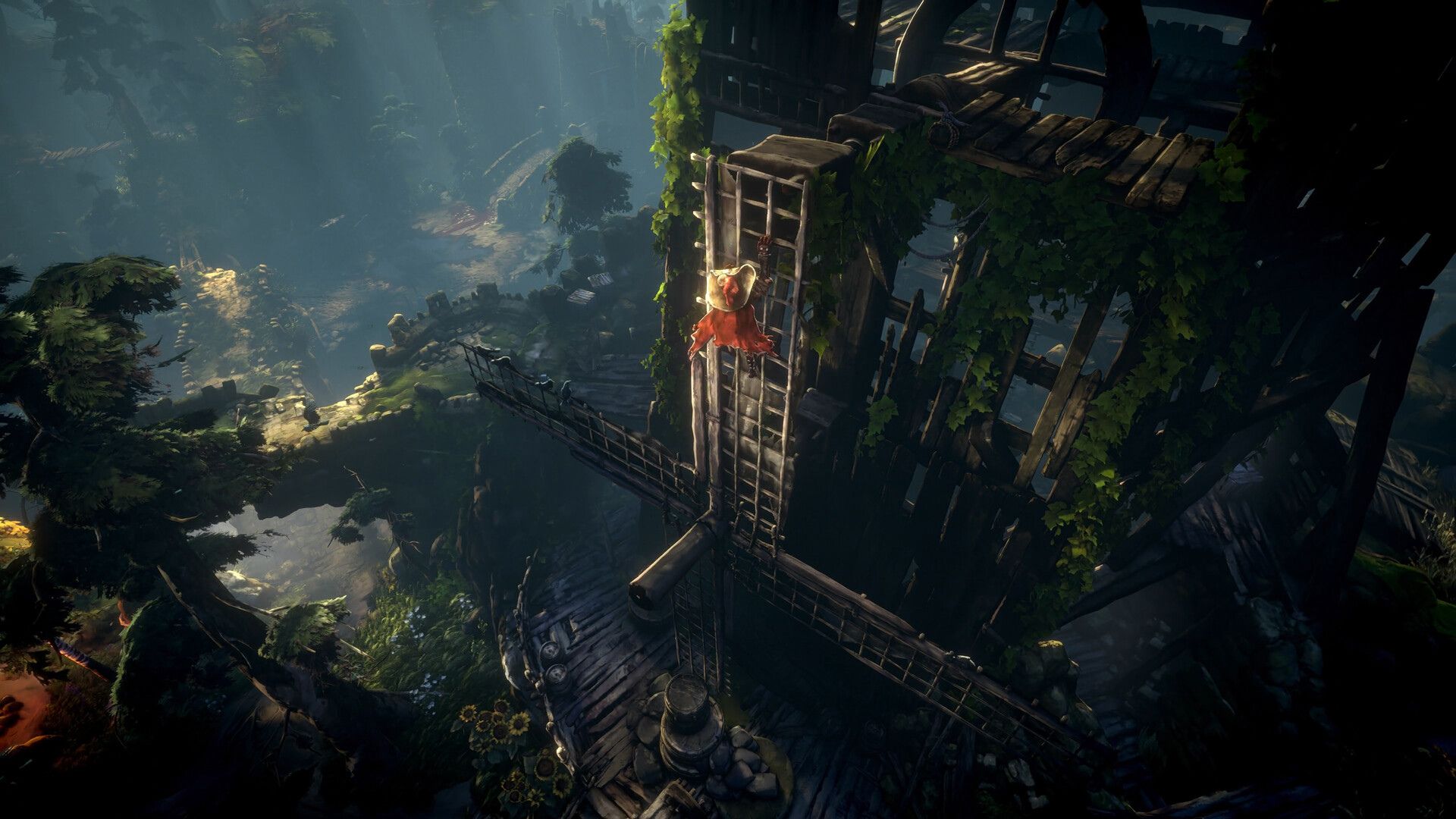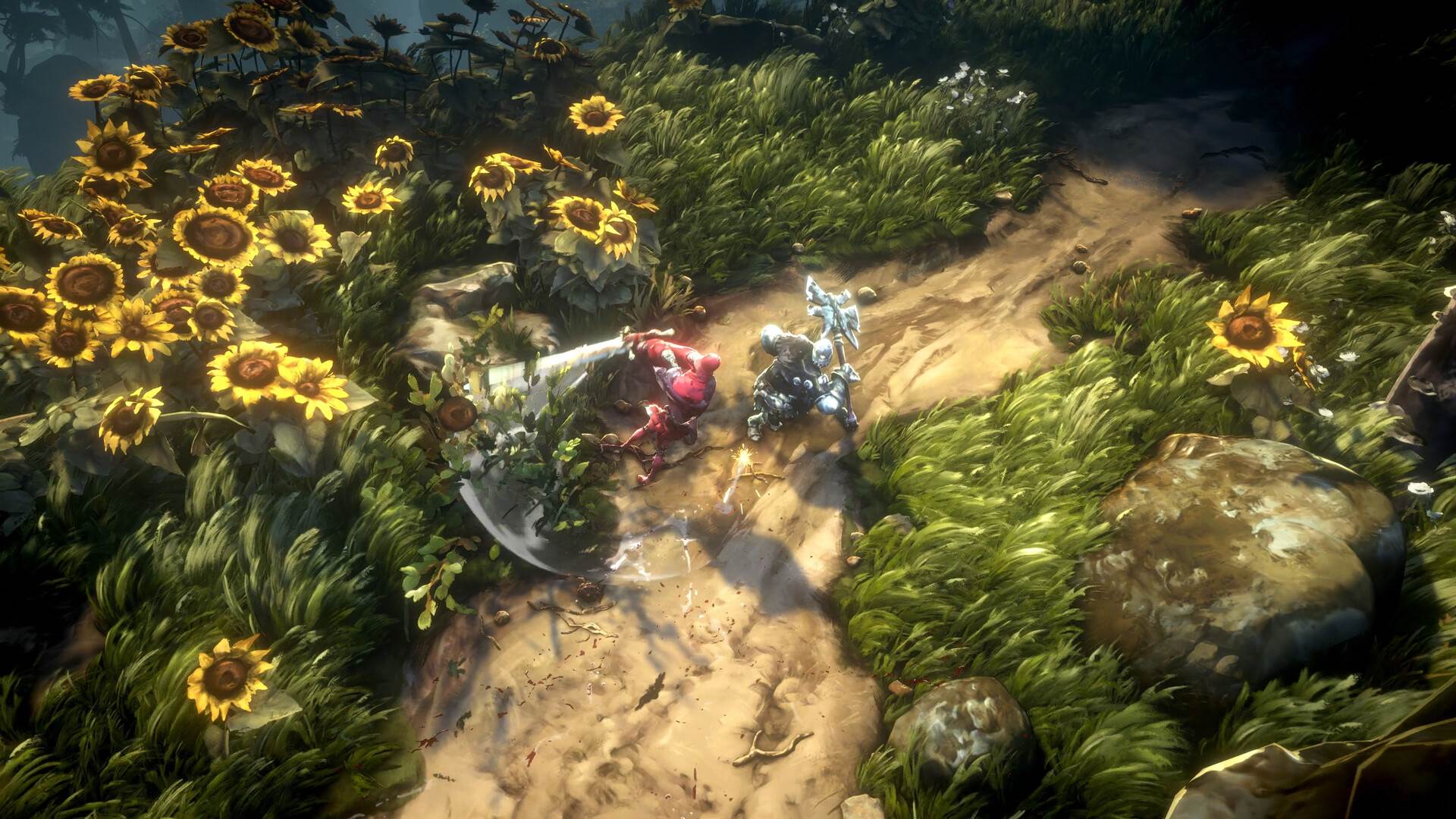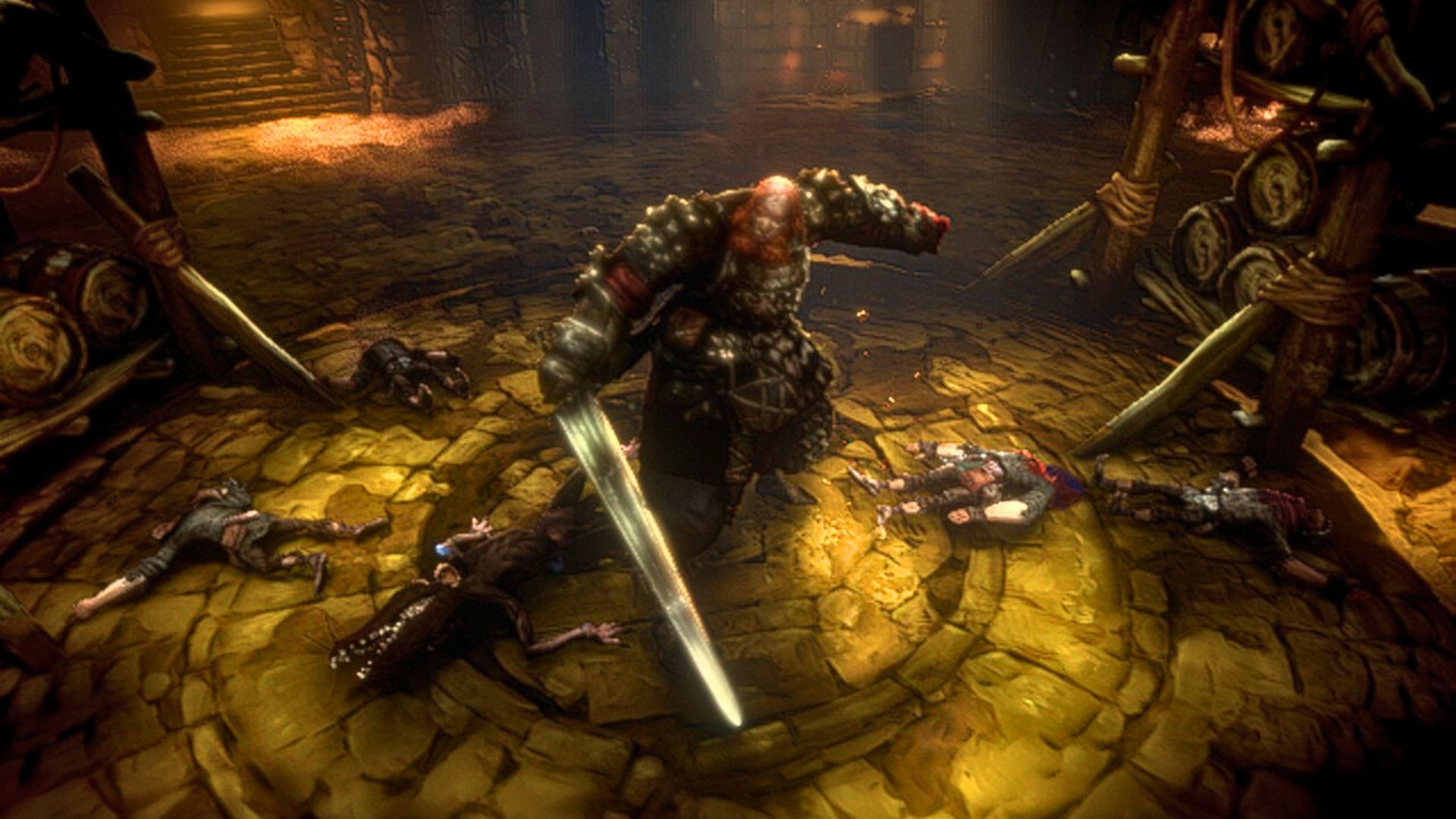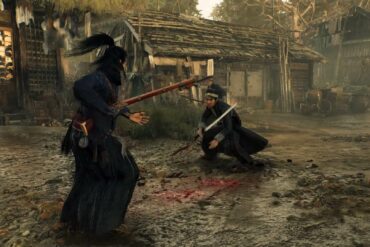After sinking in nearly 30 hours in Early Access, I feel like I can confidently say that No Rest for the Wicked will be a fantastic game when it eventually launches in 1.0. There’s so much to love about its jaw-droppingly gorgeous visuals, brilliant musical score, and refreshing blend of ARPG mechanics and tense skills-based Soulslike combat. However, it has a long way to go before it reaches its full potential. The game has been riddled with optimization issues since its Early Access launch, causing frustrating issues with performance early on. That’s not even to mention the game’s lack of quality-of-life features, which can make it a bit of a slog. However, recent patches indicate the game is moving in the right direction to be one of the most refreshing shake-ups of the ARPG genre to date.

“No Rest for the Wicked’s ominous orchestral themes and softly sung choirs evoke Tolkien-esque feelings of grandiose and thoughtful melancholy.”
I can summarise my mixed experience of No Rest for the Wicked from the first time I booted it up. From the get-go, it makes a memorable and striking impression. The familiar Moon Studios logo flashes on the screen while the game’s beautiful score plays in the background. Its ominous orchestral themes and softly sung choirs evoke Tolkien-esque feelings of grandiose and thoughtful melancholy. I closed my eyes to take it all in, only to be greeted by a perpetual black screen when I opened them. It turns out the game had crashed, forcing me to restart before I even managed to play.
Thankfully, the musical score is so wonderful that I welcomed the opportunity to hear it again. This black screen became a familiar sight throughout my experience of No Rest for the Wicked – something I’ll get to later. This is somewhat of a microcosm of my overall experience. The game’s brilliant atmosphere, musical score, and visual design keep me wanting to return, despite the technical hiccups I may experience along the way.

“The alluring visuals, brilliant voice cast, and moody lighting all coalesce to make a game that absolutely oozes atmosphere.”
Eventually, I was prompted to create my character when I reached the main menu screen. Though the option is appreciated, it pales in comparison to the recent Dragon’s Dogma 2’s stellar character creator. I was immediately taken aback and couldn’t help but laugh at the character model’s outright bizarre design in No Rest for the Wicked. They certainly don’t resemble any human being I’ve ever seen. Their arms are gangly and enormously long, while the head is tiny compared to the rest of their body. After heading into a new game and experiencing this odd character design within the world, I could see this was a bold choice that I grew to like for its striking uniqueness. It’s just a little jarring at first.
Visually, No Rest of the Wicked is jaw-droppingly gorgeous to look at in almost every conceivable way. The game is developed by Moon Studios, the makers of the ever-popular Ori games. Both Ori titles were visual treats from start to finish, and No Rest for the Wicked follows suit. This time around, Moon Studios has opted for a stylized visual design akin to a 19th-century Victotorian-era watercolor painting come to life. The alluring visuals, brilliant voice cast, and moody lighting all coalesce to make a game that absolutely oozes atmosphere. This is most apparent when treated with one of the game’s gorgeous cutscenes that perfectly set up its intriguing story.

“If there was ever an argument for video games as art, hardly any other game can come close to what Moon Studios has pulled off here.”
In No Rest for the Wicked, you play as a Cerim, a holy warrior who must fight back against the evergrowing Pestilence in Isola Sacra. This Pestilence is a nasty plague that is spreading across the land. It’s transforming the island’s denizens into a series of nasty monsters. It’s your job to use your abilities to purge this plague while embroiled in a political struggle between the rulers of the kingdom and the rebels who wish to take it down.
The plot is interesting enough and does its job of getting you from point A to B. It’s hard to tell how the overarching plot will pan out, as Early Access only contains the game’s first act. By the end of the story (after 20 hours or so), I felt satisfied. I was sufficiently intrigued to see what would happen next. It’s all pretty standard fantasy fare: you are the chosen one who must rid the land of evil.

However, its compelling cast of characters and amazing visual design have kept me glued to the screen. I felt a genuine sense of delight whenever I was treated to a cutscene in No Rest for the Wicked. Any still frame could come straight out of a graphic novel: it is bold and beautiful. The art style is nothing short of spectacular, and I just wanted to live and breathe in this world. I was itching to see the next cutscene just because of how astoundingly gorgeous it all looks. If there was ever an argument for video games as art, hardly any other game can come close to what Moon Studios has pulled off here.
“From the moment you wash up on the plague-filled shores of Iosla Sacra, you are immersed in expertly crafted environments that are a joy to explore.”
The fantastic visuals extend from the game’s cutscenes and into exploration in No Rest for the Wicked. From the moment you wash up on the plague-filled shores of Iosla Sacra, you are immersed in expertly crafted environments that are a joy to explore. In Early Access, you can traverse through three distinct locations in the open world. These include the rundown Mariner’s Keep castle, the plague-filled Black Trench sewers, and the Nameless Pass, a mountainous area that houses an abandoned mine. Each area is chock-full of winding paths to explore and discover. I found the game’s verticality particularly impressive. It prompts you to climb to the highest mountain peak and descend to the lowest dungeon depths in search of loot.
The game opts for an isometric viewpoint with a fixed camera. This means you’ll need to explore your field of view as much as possible to ensure you don’t miss anything. The map design is smartly designed as it places hidden items and areas just out of sight. You will often see something intriguing in the corner of your eye, begging you to go and take a look. More often than not, it will be in higher areas you cannot reach yet.

“The ever-changing map adds considerable depth while revitalizing areas you’ll frequently visit.”
As a Souls-inspired game, there is plenty of loot and resources to collect to upgrade your gear and equipment. However, unlike a Souls game, you have no bonfires to rest at. Enemies also do not reset after you die. It’s a pretty smart system that makes backtracking feel far less painless. This way, you can easily clear a path back to a difficult enemy.
When you die, you spawn at Cerim Whispers and can only fast-travel between the primary one in town and the last one you interacted with. This is to encourage exploration of the game’s ever-changing map. The map changes each time you leave an area after a short period. It updates its enemies, resets any depleted ore or tree nodes, and spawns new loot. This adds more depth to the map and revitalizes areas you’ll frequently visit while doing quests there.

Talking of loot, No Rest for the Wicked opts for a similar approach to other ARPGs. There is a three-tiered system consisting of Common, Rare, and Legendary gear. Common gear has no special effects but can be heavily customized with Runes. Rare gear is less customizable but can have positive and negative enchantments. Legendary gear, as you would expect, merges the best of both. It has powerful Runes, stats, and enchantments (with no ill effects), but are the rarest gear pieces in the game.
“I spent a lot of time managing my inventory when I would have much rather explored the game’s gorgeous environments.”
You can get gear as loot drops from defeating enemies and opening chests. All weapons, armor, and equipment you stumble across are random. This prompts you to explore and loot as much as possible in service of the game’s RNG system. However, as with other ARPGs, you can quickly fill up your inventory to the point where it becomes bothersome. I spent a lot of time managing my inventory when I would have much rather explored the game’s gorgeous environments. Nevertheless, loot still feels more meaningful than what you’d find in a typical ARPG.
All that looting is absolutely essential for your continued survival with No Rest for the Wicked’s tough-as-nails combat. It opts for an animation-led skills-based combat system pulled straight out of a Souls game. Blocks, dodge rolls, and parries are the key to success. There is a heightened emphasis on keeping an eye out for an enemy’s telegraphed attacks. As with any Soulslike, the combat consists of punishingly difficult encounters with a small handful of enemies at a given time. Boss encounters are even more demanding: you will die repeatedly before attaining victory.

“Early on, I fell in love with a one-handed axe with a “fire throw” rune equipped that made me feel like Thor with Mjolnir as I threw it out to decimate my foes.”
Thankfully, there are many weapons to play around with that make combat feel distinct and unique. From heavy two-handed greatswords, speedy devastating daggers, and the tried-and-true sword and shield combo, something will likely suit you. However, melee builds fare far better than ranged builds, with magic users getting the short end of the stick early on. To pull off any spell, you must use Focus (kind of like Mana), which drains really fast. Most powerful spells can take a while to cast and do far less damage than most melee-focussed builds. It also doesn’t help that melee builds can also use Runes, which you can slot into any open Rune slot.
Runes act as spells in No Rest for the Wicked and can add significant power to your build. It’s a brilliant way of customizing your weapons even further to suit your playstyle. Early on, I fell in love with a one-handed axe with a “fire throw” rune equipped. It made me feel like Thor with Mjolnir as I threw it out to decimate my foes. In fact, this ability is so good that I opted for little else during my playtime. That’s a shame because there are a lot of Runes on offer, but I didn’t feel incentivized to check most of them out because the game doesn’t do a good job of telling you what they do before you invest in them. Hopefully, this will change in a future patch.

“Not being able to respec prevented me from experimenting with other builds. It made me feel like I was missing out on a major portion of the experience.”
Drawing heavy inspiration from the Souls series, you’ll have three attribute points to assign when you level up. There is currently no respec system, so you’ll need to choose wisely where you spend your points. To maximize your stats, you’ll need to stay locked into a particular build so you can face the tougher challenges later on. Not being able to respec prevented me from experimenting with other builds. It made me feel like I was missing out on a major portion of the experience. I really hope a respec option is implemented further down the line.
Once you’ve finished the story in Early Access, there’s still plenty for you to see and do in No Rest for the Wicked. One of the game’s ongoing activities is upgrading Sacrament, the main city of Isola Sacra. It’s a living and breathing hub that changes depending on how much you are willing to invest in it. The city builder NPC demands plenty of wood, ore and clay from you to upgrade the various vendors in town.

At first, these vendors will have small, humble tents with very little stock. At the end of the game, they each have their own buildings with high-level gear and resources for you to utilize. If you’ve put the work in to upgrade them. I liked this aspect of the game, as it made exploring and finding resources worthwhile. It provided a meaningful goal for the end of the game and gave me a reason to explore its beautiful zones yet again.
“I’m excited at the potential that Cerim Crucibles can bring to No Rest for the Wicked’s endgame experience.”
The most interesting aspect of No Rest for the Wicked’s endgame is the roguelike-inspired Cerim Crucible dungeon. Only unlocked after beating the main story in Early Access, these dungeons contain randomly generated floors with a series of highly difficult enemies to defeat. The final floor contains the hardest boss in the game, the Echo Knight. The Crucible is undoubtedly the hardest content the game has to offer, but it is more than worth attempting. Running through it will grant you high-level loot and huge amounts of XP to level your character.
In Early Access, there is currently only one Crucible Dungeon in the game, but Moon Studios have promised to implement more over time. They have expressed that they intend this to be almost an entirely separate ongoing experience from the main game. As a huge roguelike fan, I’m excited at the potential that Cerim Crucibles can bring to No Rest for the Wicked’s endgame experience.

“Hands down, the worst aspect of the game is its performance and optimization in its current state.”
As much as I have enjoyed my time with No Rest for the Wicked, several glaring issues have negatively impacted my experience. Hands down, the worst aspect of the game is its performance and optimization in its current state. I opted to play the game on my Steam Deck (original model). It seemed like the perfect fit for an isometric ARPG experience, and I have already sunk countless hours into Diablo 4 on the Deck without any issues. Shortly before its Early Access launch, Moon Studios said they were working to get the game running on Steam Deck. As their previous Ori games run beautifully on Valve’s handheld and even the Nintendo Switch, I thought it was a no-brainer to dive right in. Unfortunately, I was wrong.
From the get-go, it’s clear this is not meant to be played on the Steam Deck in its current state. Even with all graphics settings turned down and a frame rate cap of 30 FPS, the game would slow down to a snail’s crawl during cutscenes and busy combat scenarios. It wasn’t too much of an issue while exploring and facing basic enemies, but it can be particularly frustrating during boss fights. I noticed the frame rate struggle to hit 30 FPS during my first boss encounter. Thankfully, I crafted enough meat and mushroom soups to keep my health topped off during the fight, but this shouldn’t be the way to earn victory.

I also lost count of the amount of times the game hard-crashed, forcing me to reset my system entirely. Playing on the Steam Deck was an extremely frustrating experience and is something I absolutely do not recommend. From what I hear, performance on PC hasn’t fared much better, though things will likely improve in this regard with future patches and hotfixes as it moves out of Early Access.
“Another major concern I share with the community is the distinct lack of quality-of-life features in the game’s current state.”
In fact, Moon Studios has already put out several Hotfixes that address some of these performance concerns since its launch. They also addressed some fan concerns with some of the game’s mechanics, such as its controversial durability system. In No Rest for the Wicked, the main penalty for death is losing durability on gear. This then locks you out of using them once this value reaches zero. At launch, many felt that the penalty was too severe and punished you for exploring and experimenting. Moon Studios took these criticisms on board and has since significantly reduced the cost of durability on death.
Another major concern I share with the community is the distinct lack of quality-of-life features in the game’s current state. Things like lugging resources back and forth between your stash chest and vendors are unnecessary. However, with Moon Studios’s persistent efforts to update and patch the game, I am confident that performance and quality of life will improve in due time.

“The potential of what’s on offer here has me very excited for what’s to come for No Rest for the Wicked.”
I will say that, despite its glaring performance, optimization, and quality of life issues, I persisted with No Rest of the Wicked because I kept wanting to immerse myself in its world. It’s a testament to just how good its gameplay, exploration, visuals, and atmosphere really are. I also love the unique blend of ARPG loot-based gameplay with tense skills-based Soulslike combat mechanics. Isola Sacra is a beautiful and dangerous place to explore with an ever-changing map you can sink countless hours into. There is also great potential for replayability with its roguelike endgame Cerim Crucible dungeon. All of this is underpinned by one of the most unique and genuinely best-looking games I have ever played.
The potential of what’s on offer here has me very excited for what’s to come for No Rest for the Wicked. However, in its current state, I would definitely recommend waiting for a few updates to smooth things over before jumping in. When you do, though, you’re in for a heck of a ride.
Disclaimer: Game Crater was given a code for this preview.












